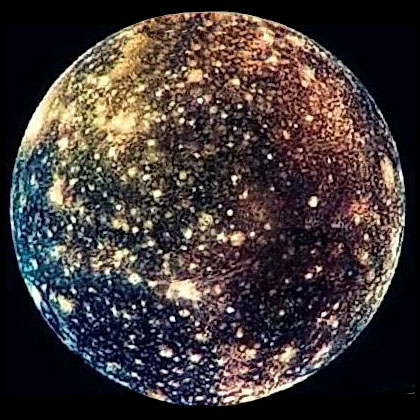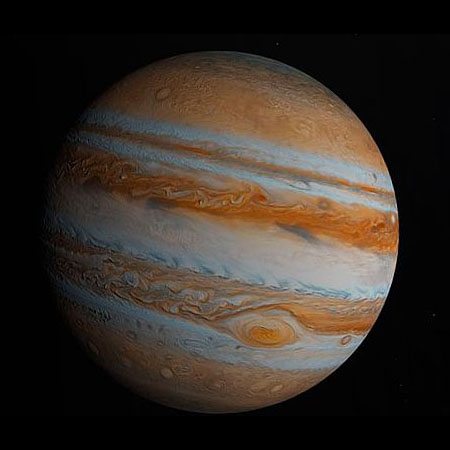Cold as Ice – the Ice Moons of Jupiter
Note that the “ice” of the outer Solar System is really a mix of water ice and ammonia cleaning fluid which softens the ice quite a bit. If it was just water ice at the extremely low temperatures of the outer Solar System minus 270 to minus 170 degrees C “ice” would be simply too hard and too stiff to do half the things I’m going to tell you that ice really does.
Because Europa probably has a subterranean salty ocean under the outer ice, many planetary scientists draw parallels with the ice caps on Earth especially where Earth’s ice is underlain by ocean water. How realistic is this comparison? This is an important question because, if the comparison is good, then we have a natural laboratory for Europa right here where we can access it.
Table of Contents
Consider the Arctic Ice off the North end of Greenland. Land ice and sea ice behave quite differently. The land ice is apparently quite solid and featureless, but the sea ice is fractured and broken into large chunks (icebergs) that are well defined and separated from each other by a matrix of thin ice. Locally, small isolated areas of open water that have not linked up to form channels. Elsewhere off North Greenland, solid sea ice passes progressively southward through a transition into icebergs surrounded by thin ice and lots of open water. Cracks in the solid sea ice are about the same scale as the icebergs that are calved from it, which tells us that the cracks in the ice do not grow in length beyond their original size. This will be an important observation to keep in mind when we look at the Outer Moons
Ice Moon Europa
Now let’s move out to Jupiter and take a look at the Ice Moon Europa. The low density of impact craters on Europa tells us that its icy surface is very young and very active. Young ice has effectively erased all evidence of the Great Bombardment of about 4 Billion years ago. Because of the orbital mechanics of Europa in Jupiter’s powerful gravity field, the Moon is flexed like a tennis ball. This generates relatively straight cracks or fractures in the surface ice, that can be over 1500 Km long. These long fractures are characteristic of Europa, but so is the “Chaotic Terrain” where the long fractures are distinctly absent. The ice that makes up Europa’s fractures is different to the ice that the fractures cut across. This tells us that the fractures are actually narrow zones where ice with impurities probably mostly carbon was injected from within the Moon into the long cracks.

So what does the ice that the fractures are cutting across look like close-up? Well more fractures!! In fact it’s difficult to find a part of Europa’s surface that is not fractured. Some are discrete simple ridges. Others are more complex and have a central valley down the middle they’re called triple bands or tribands. Some ridges clearly cross-cut others, from which we can work out a time sequence or a history of fracturing and injection of new ice. In addition to the ridges, there are broad zones with complicated shapes and lateral branches, all filled with new ice that itself has an internal structure.
Chaotic Terrain cuts and therefore is younger than both the broad zones and the long ridges. What exactly is Chaotic terrain? It comprises ground with a rubbly surface, very different from the ice surrounding it. It either cuts or sits on top of all the structure in the surrounding ice, so it’s commonly the youngest thing in a given Europan neighbourhood. In effect, Chaotic Terrain is a gigantic ice eruption in other words the product of ice volcanism.
How deep do these surface features go in Europa’s ice? Complex networks of ridges and tribands that cross-cut and offset each other can be interspersed with ice blisters, technically referred to as “Freckles”, which are in fact volcanoes made of ice that rose from within the Moon. The ridges and freckles avoid each other, as though the one is controlling the distribution of the other. Either the ridges deep walls of strong ice that guide the rise of the ice volcanoes, or the ice volcanoes are deep pipes of strong ice that influenced the propagation of the cracks that give rise to the ice ridges.
This pattern of ridges and ice volcanoes is also developed on a very large scale. The largest ice volcanoes on Europa are Thera and Thrace. The latter rises above the Moon’s surface as you might expect, but the floor of the former sits below the average surface level of its surroundings in effect it’s a hole!
Now, how does all this compare with Earth’s icecaps? Some planetologists have identified “icebergs” in terrains of blocky ice on Europa that they compare to those on our planet. The boundaries of these ice blocks truncate ridges and tribands and disrupt ice volcanoes. However, these blocks are not icebergs! They are not separated from one another by a matrix of thin ice, and there are no dilated cracks. Instead, the blocks are in a matrix that has destroyed the ridge structure that is still visible in the blocks and the blocks have been shuffled and misoriented with respect to each other. Commonly, the blocky terrain is then cut by very late, very long fractures. I don’t think that blocky ice is not an analogue of Polar Sea Ice at all! It is a very coarse variety of Chaotic Terrain. In other words this is the product of Ice Volcanism, something we don’t see on Earth and certainly not at this scale.
Callisto
If Europa is the type example of a young and active Ice Moon surface its sister Callisto is just the opposite. Callisto’s surface is densely scarred with evidence for major meteoric bombardment, and therefore must be ancient. The question is of course did it look like Europa in its once active youth? I don’t know, but that active youth would not have been very long lived because unlike Europa Callisto is not differentiated into a core, a mantle and a crust. which tells us that it wasn’t warm enough internally to be active for very long after its formation.
The average surface of Callisto is covered with impact craters, but there’s something a bit odd about this battered icy. The walls of the craters look like they have been “eaten away” they are nothing like those of the Rocky Planets. Locally, the crater walls seem to have moved around, even slid down into the impact crater pit. In other cases, craters have been partially flooded, but by what? The bottom line is that the ice of Callisto’s surface is capable of crumbling and moving around like sand, which is pretty strange behaviour for ice.

Talking of strange behaviour, there is evidence that the strength of Callisto’s icy surface has changed with time. Older craters that are battered by younger ones tend to be less well defined than the younger craters. This suggests that the older craters formed when the surface ice was too soft and weak to support the pressure difference created by the topographic relief between a deep crater floor and high crater walls, so the craters collapsed rather like melting ice cream. The younger craters formed when the same ice was stronger so they’re well formed and preserved. The simplest way to account for this is if Callisto cooled from cold to even colder early in its history, thereby allowing the ice to get stronger with time.
Finally, Saturn’s Moon Iapetus provides us with a spectacular example of mechanical ice behaviour. A giant rubble landslide of crumbly ice has half-filled a crater that sits within an even larger crater. The cliff that represents the scar the landslide left behind is 15 Km high! I have to keep reminding myself that this is ice we are looking at, behaving just like rocks do on the Rocky Planets.
In summary, the ice surfaces of the Outer Moons are nothing at all like Earth’s Polar Sea Ice. On Europa the classical Ice Moon the surface ice features are a mix of fracturing and ice volcanism that is nothing like what we see on Earth. Why the difference? Probably because Europa’s surface ice sits on a substrate of relatively “warm” perhaps “slushy” ice, while Earth’s ice sits directly on water. However, there are those who think that Europa contains a subterranean ocean, but in this model the Europan ice is much thicker than Earth’s Sea Ice. Either way there’s a major difference between the ice of the Outer Moons and Earth’s ice caps.
Galileo Galilei
A man named Galileo Galilei who lived about 400 years ago. He was an Italian astronomer who dared to explore the universe with more than the naked eye could see. He made one of the first telescopes and used it to peer up at the night sky. One night, in 1610, he was studying Jupiter and saw many points of light surrounding it. He thought they were just stars until the next evening when he looked again and saw that they had moved. He concluded that they were moons orbiting around Jupiter. These moons were named after the companions of the Roman god Jupiter and are: Io, Europa, Ganymede, and Callisto.
Now, fast forward 379 years to 1989, a few years before I was born. NASA, the National Aeronautics and Space Administration, launched the Space Shuttle Atlantis. Once it got up into space, it opened its payload bay doors and released

The spacecraft began a six-year long journey to Jupiter.
In 1995, it reached its target and began orbiting Jupiter and sending back information and photos about the four Galilean moons for astronomers to study.
Io is the closest moon to Jupiter with a gravitational pull so strong that Io is the most volcanic body in the solar system. Its terrain is mostly flat plains rising no more than 1 kilometer above the surface. Mountain ranges up to 9 kilometers high have also been discovered along with erupting volcanic lava fountains.
The next moon is Europa. Small blocks of ice float on an invisible ocean of water making it look like broken glass repaired by an icy glue oozing up from below. Europa is stretched and compressed in different directions by the gravity of Jupiter and the other moons.
The Galilean Spacecraft traveled so close to Europa that if there were something there the size of a school bus, it would have been detected.
Ganymede is the third moon from Jupiter. It is the largest moon in the solar system, even larger than Mercury and Pluto. If Ganymede orbited the Sun instead of Jupiter, it would easily be classified as a planet. Ganymede has a rocky core, a water and ice mantle, and an icy rocksurface. It sure would be cold to live on Ganymede!
Finally, Callisto is the farthest away of the Galilean moons. Callisto has a lot of craters, most likely created by impacts with asteroids from the asteroid belt. Its interior is probably similar to Ganymede. Callisto’s surface is the darkest of the Galileans, but it is still twice as bright as our own moon.
In September 2003, after 8 years of exploring Jupiter and the Galilean moons, NASA purposely set the Galileo Spacecraft on a collision course with Jupiter. The onboard propellant was nearly gone and they did not want the spacecraft to crash into Europa accidentally.
The Jupiter Icy Moons Orbiter is a proposed NASA mission to explore the three icy moons of Jupiter: Callisto, Ganymede, and Europa. They are looking for answers to some intriguing questions such as: “Could there be life on Europa in the underground seas?” “Is there more than just a few microbes living in the water?” “Could there be life like there is on Earth?”
